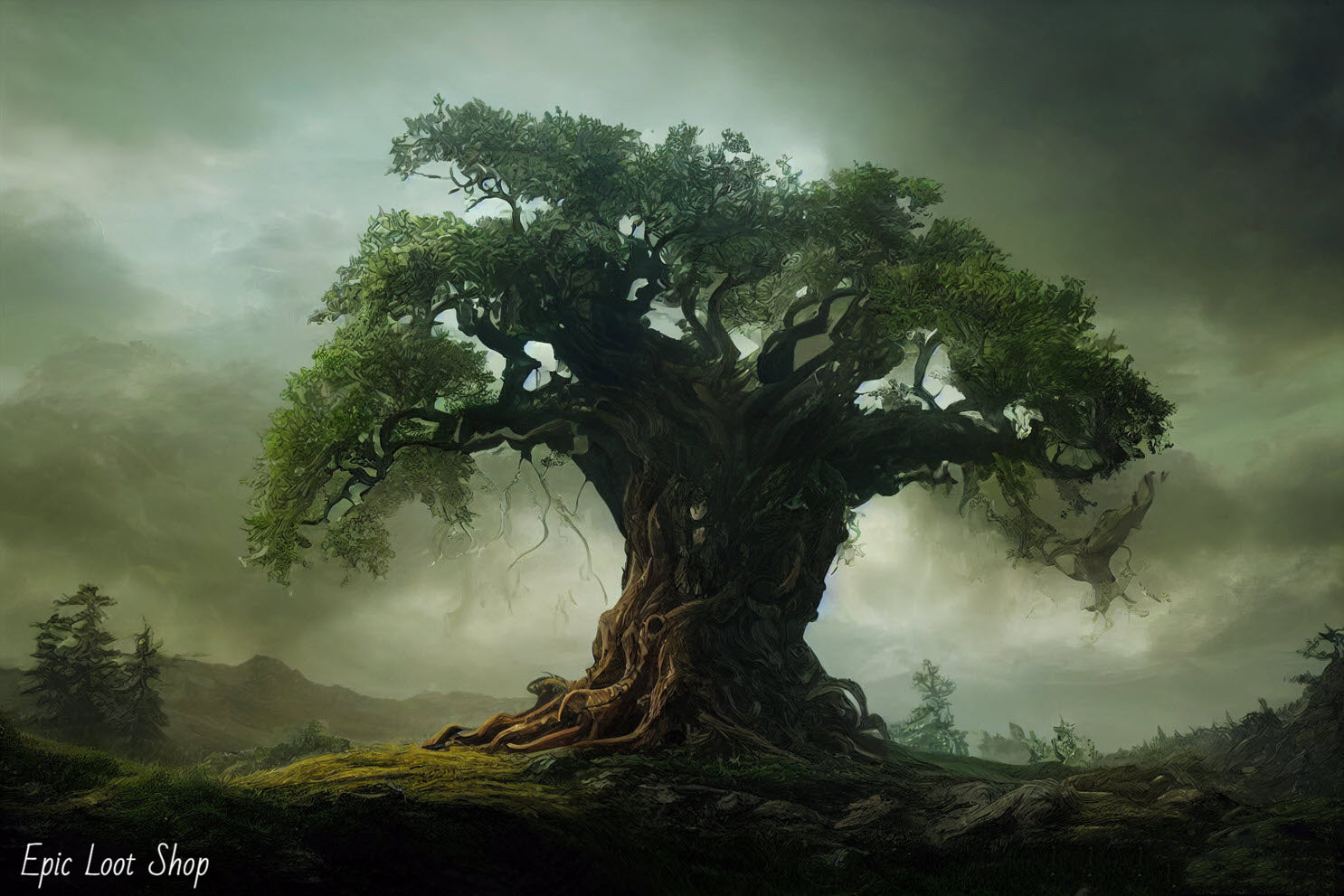Yggdrasil - The Tree Of Life In Norse Mythology
Yggdrasill, or Mimameidr in Old Norse, refers to the legendary tree in Norse mythology that holds up the universe. It is said that one of its roots extended into Niflheim, the underworld; another into Jötunheim, land of the giants; and the third into Asgard, home of the gods. A squirrel named Ratatosk carried messages between Yggdrasill and Nidhogg, a dragon that lived at its base and gnawed at its roots.
What does Yggdrasil symbolize?
The Norse tree of life is a large ash tree named Yggdrasil, which connects the Nine Worlds and is the center of the cosmos. Its branches stretch over every living creature, holding up the world and holding it together.
In Norse mythology, Yggdrasil symbolizes many things. It represents the cycle of life, death, and rebirth. It also symbolizes the power of knowledge: those who do not seek wisdom will never reach its heights. The tree contains the well of Urd, which holds all past and future events. In fact, if you could go to the bottom of this well and drink from it, you would know absolutely everything that ever happened or will happen.
The great dragon Nidhogg gnaws on Yggdrasil's roots in his attempt to destroy it and bring about Ragnarok (or as we know it: The End Times). However, no matter how much he eats away at its roots, Yggdrasil remains strong for eternity.
Is the tree of life the same as Yggdrasil?
The tree of life is a concept that comes up in many religions and mythologies, and the concept has been adapted in different ways since it first appeared in ancient Mesopotamia. Today, most people associate it with the Hebrew Bible's account of creation—with its roots in the underworld, trunk in the middle world, and branches reaching to heaven—but it also appears in other stories that have been told by other cultures throughout history.
We're going to explore the connection between this ancient idea and one particularly famous variant: Yggdrasil, the world tree of Norse religion. Though there are many differences between the two versions, they share some common elements. They both feature a massive tree that connects different worlds; they both have their roots in a watery underworld; they both have branches that are home to creatures like serpents, birds, and squirrels; and they even each contain wells or springs of water at their roots. Even though these two trees look quite different on the surface, when you dig down into their details (and even their names) you see that there are more similarities than you might think!
Who created Yggdrasil?
The origins of Yggdrasil are a mystery. While it is certainly the most famous tree in Norse mythology, there is no definitive date of creation for Yggdrasil, and it's hard to say when the tree's origin was recorded in Norse mythology. While the tree is referred to in some of the earliest texts, there is no definitive date that it appears. The tree could have been created before the text was written, or it could have come after, with the writings being a way for the story to be passed down over time. One thing we can be sure of is that Yggdrasil has existed before most people believe Old Norse texts were written down.
What is Yggdrasil used for?
Yggdrasil is a mythological tree of life that's been used for various purposes for thousands of years. As a symbol of the cosmos, it was originally an important part of Norse mythology. In addition to being a sort of axis mundi and world tree, the ash tree also represents wisdom, as well as insight and foresight. In fact, Yggdrasil was what Odin sacrificed his eye in exchange for wisdom and power.
In modern times, Yggdrasil is often used as a symbol of environmentalism or earth-friendly living, perhaps because it's one of the only living things that stands tall enough to reach the heavens. The branches have been used to create walking sticks and staffs for centuries, as well as jewelry and other works made from both the wood and certain varieties of leaves. Some people even use Yggdrasil oils and incense to help them meditate or seek spiritual guidance.
Why was Yggdrasil so important for the Vikings?
The Vikings lived in a world quite unlike the one we inhabit. They were intimately connected with nature—and they believed that everything had a spirit and an energy. The Vikings believed that their mythology was real and that the Norse gods, giants and other creatures of myth were always present. The one exception to the all-seeing eyes of the Norse pantheon, however, was Asgard, home of the Aesir gods.
In order for humans to interact directly with the gods or any of the other mythological creatures (like elves or dwarves), they needed a way to connect their world with the intangible world of myth. This connection was made through Yggdrasil, the great tree at the center of Norse mythology.
Who sits at the top of Yggdrasil?
In Norse mythology, there is a creature named Veðrfölnir. He's the one that sits between the eyes of an unnamed eagle perched on top of the world tree Yggdrasil. His name translates to "storm pale," "wind bleached," or "wind-witherer." He's also sometimes anglicized as Vedrfolnir, Vedurfolnir, or Vetrfolnir. How'd he get up there? Well, according to the text Hrafnagaldr Óðins (Odin's Raven Spell), his father was a giant named Suttungr who lived in a place called Gunnlogi (Gunnlögr in Old Norse). It was apparently customary for giants to steal from Odin and hide their acquired booty in secret places. Did Suttungr know that Veðrfölnir would be sitting on top of Yggdrasil? It's not clear. But it does seem like he knew that he'd have to keep his treasure hidden from Odin because if Odin knew about it, he'd surely try to get it back by any means necessary.
How do you pronounce Yggdrasil?
The word Yggdrasil has several pronunciations depending on the origin of the speaker and the region of the world from which he or she comes. The most common pronunciation is to say it as if it were spelled "YG-DRA-sill." This pronunciation is used by many English speakers, including those who are familiar with Nordic languages, such as Icelandic, Swedish or Norwegian.
The second most common pronunciation is to say it as if it were spelled "yeeg-drah-sill." This is the preferred pronunciation for speakers of Germanic languages (including German, Dutch and Old English) who have a difficult time with "th" sounds. The third most common pronunciation is to say it as if it were spelled "ig-drah-sill," which originates from the Russian language. There are also some other variations on these three pronunciations that are used in limited areas of the world.
What happens to Yggdrasil during Ragnarok?
The Poetic Edda describes what happens to Yggdrasil at the end of the world. Though it's a story that is so old that no one knows exactly how much of it is true or simply moral teachings and allegories, there are some elements that seem to hold up under a modern interpretation.
When Ragnarok comes, Yggdrasil will tremble, and all the trees and even the mountains will fall to the ground. The chain that has been holding back the monstrous wolf Fenrir will snap, and the beast will run free. There's no telling what Fenrir will do once he's free from his bonds—will he be bound only by his hunger? Will he take revenge on those who have kept him in check for so long? We can't know for sure, but it's not hard to imagine him shaking off his chains and rampaging through Asgard until Odin takes his own life with a spear. It would be an especially tragic end for Odin, who has sacrificed himself again and again throughout history to protect those he loves.
Is Valhalla part of Yggdrasil?
There are a few different theories about the existence of Valhalla. One is that it's actually part of Asgard, the realm of the Aesir gods ruled over by Odin. The Aesir gods were known to be mighty warriors, and in fact, they were even said to be able to die in combat and then come back to life—a skill which may have been necessary for Valhalla's warriors. Another theory is that Valhalla was located on Earth, far from where the nine realms connected by Yggdrasil were located.* Yet a third possibility is that Valhalla was actually located within Yggdrasil itself, somewhere near its roots. So while we can't say for sure which theory is correct, it's clear that Valhalla was an important part of Yggdrasil and thus an important part of Norse mythology.*Some sources claim that there were two Valhallas: one on Earth and one in Asgard.
What is the rune for Yggdrasil?
The wyrd is a symbol for Yggdrasil, the World Tree in Norse Cosmology. It also represents ley lines, the complete Rune Alphabet and more.
The rune was inspired by the tree-like appearance of the Yggdrasil when it's drawn in ancient manuscripts. The runic alphabet was used to write Old Norse (also known as Norse), an early Germanic language that was spoken by Scandinavian peoples living in what is now Denmark, Norway and Sweden. The written language wasn't considered sacred, but it contained many symbols that were believed to hold magical powers. Runes were carved on talismans or used as inscriptions on swords and other metal objects as protection against evil spirits.
Conclusion
The Yggdrasill is probably the most famous tree of legend. However, its reputation is more general than it should be. It is not merely a tree that binds heaven, earth and hell; this is too easy. It is more than this; it weaves the past, present and future of the three realms together, binding them into one endlessly flowing stream of time. It encompasses all events at once, from the beginning to the end of time. Not only does it give meaning to all other mythical trees, but it unifies them as well.




Leave a comment